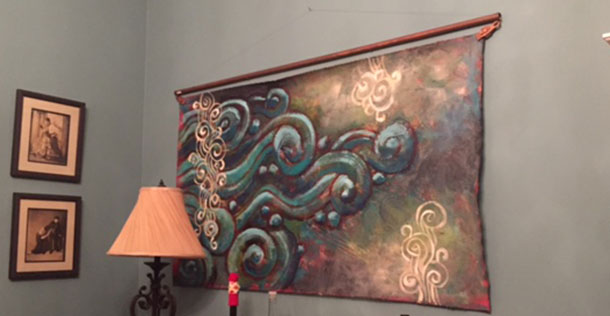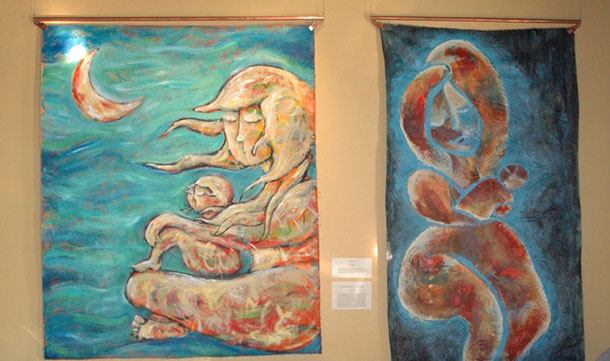Many artists create art on perfectly flat canvases and paper. These unflawed surfaces allow the artist to create whatever they want on an unhindered foundation. Though I absolutely adore working on beautifully stretched canvases or flattened papers, I have challenged myself to create artworks on several raw, un-stretched canvas.
The process is tricky as it requires me to work with the limitations and challenges of the flexible canvas as the fabric moves and folds under my paint and brushes. Sometimes it bends, sometimes it lifts, and often it doesn’t do exactly as I want it to.
Trying to create something beautiful on something you can’t control is symbolic of being a creator in life; taking what you have, even if it is less than perfect, and creating what you want out of it. In other words, it’s becoming an alchemist by taking what you have and trying to make gold out of it.
The end result is stunning: a hanging, free flow piece very reminiscent of those ancient tapestries you would find covering large walls in castles and estates.
Hanging Art Created on Raw, Un-Stretched Canvas
There are numerous ways that collectors can hang art completed on raw, un-stretched canvas:
- for rawness: pushpins into the corners, further showing the raw aspect of these pieces
- for an industrial look: add grommets to the corners and hang the works from reclaimed lumber
- for a refined tapestry look: use clips hung from a beautiful copper pipe

Here is “Woman Reclaims Body and Mind” – part of my Woman in Raw series, which shows the large artwork on raw, un-stretched canvas hanging from beautiful copper piping and clips.
If a large, raw piece doesn’t fit your decor, you can always:
- frame the piece in glass*
- have the piece stretched*
* these methods forego the artist’s intention of presentation in a raw format, but can provide a nice way to present a piece alongside a framed collection
How to Care For And Store Raw, Un-Stretched Canvas:
If you need to move or store a raw, un-stretched artwork on canvas, the way to ensure pliability of the acrylic paint and prevent cracking is as follows:
- roll the piece with the paint-side OUT while rolling over a cardboard tube
- store artwork with cardboard tube on side, rotating it every month OR, if storing it on an end, rotate it from end to end each month
- prior to unrolling it, let the piece reach room temperature or slightly warmer
More examples of how the presentation of raw, un-stretched canvas on copper piping:


